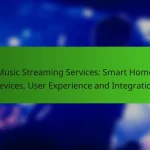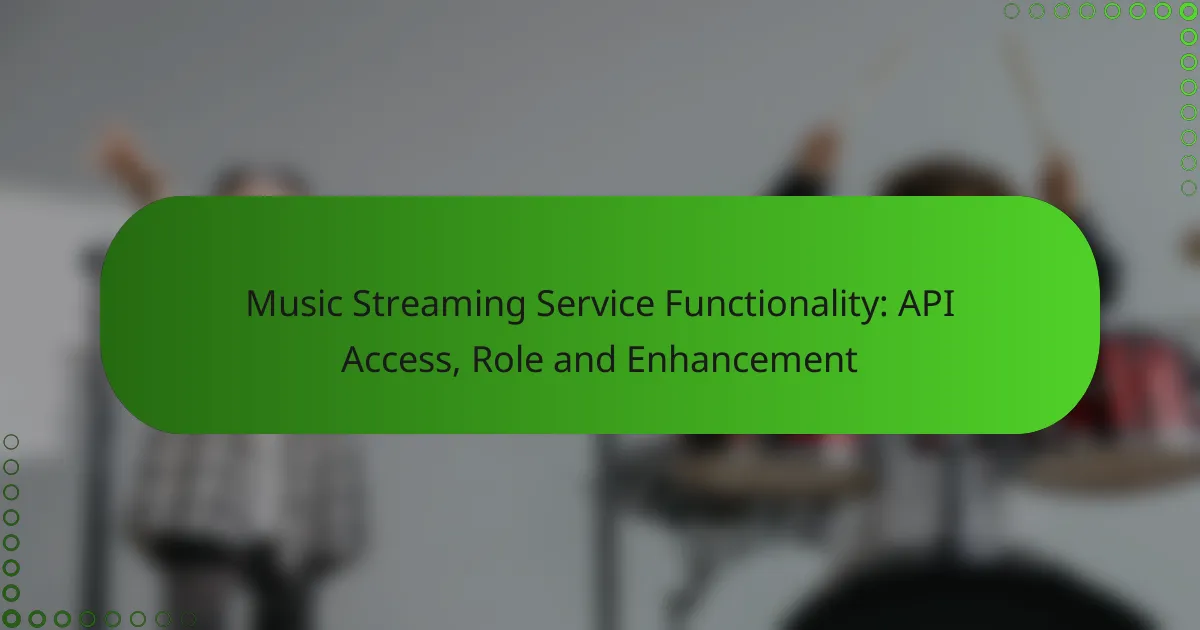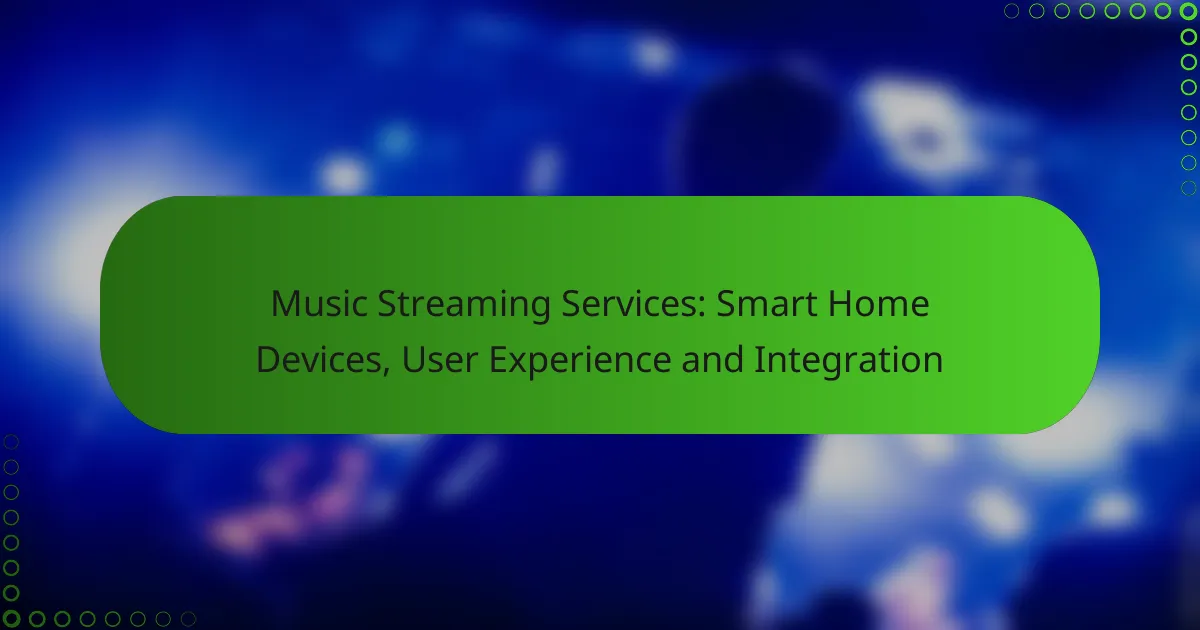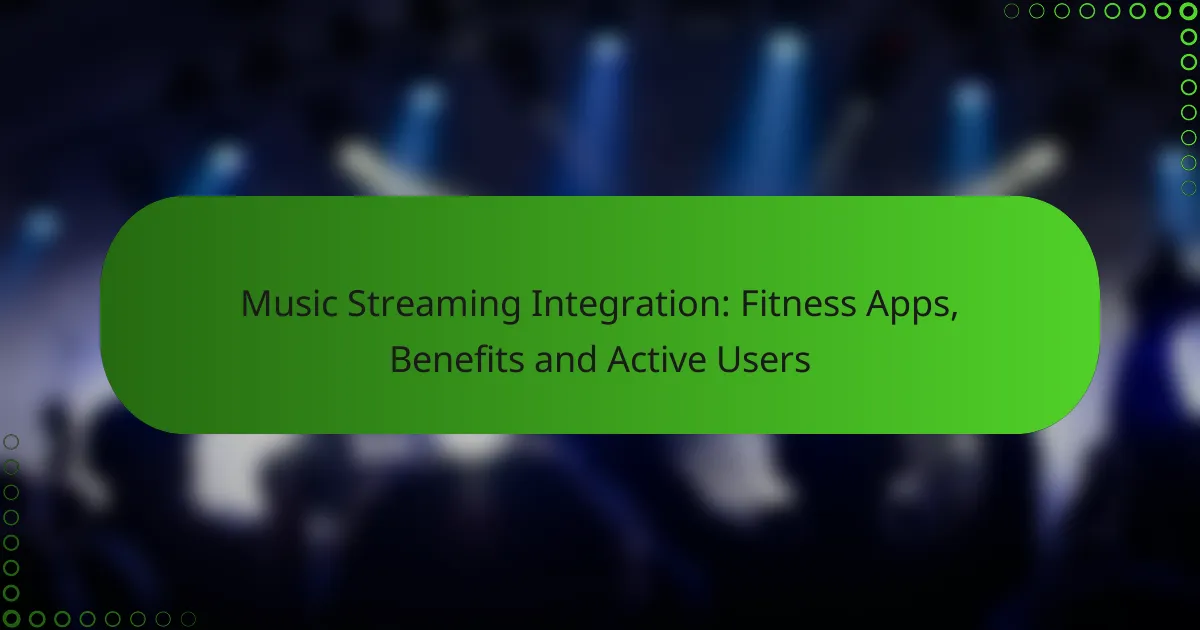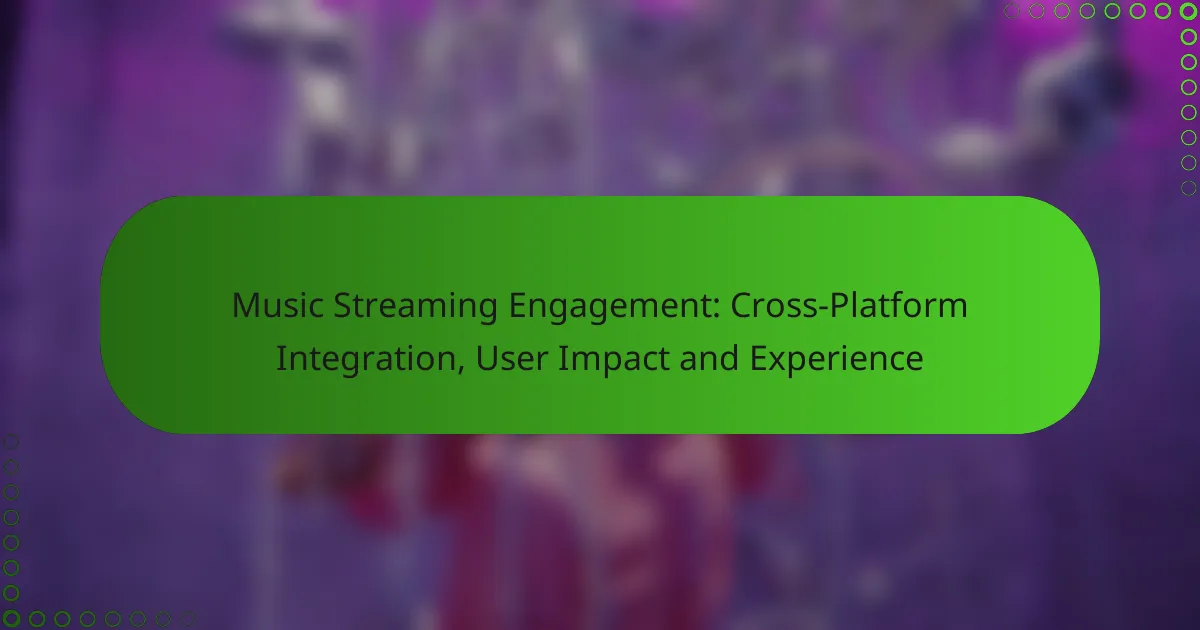Music streaming service APIs are vital tools that empower developers to access and manage music-related data while enhancing user experiences. They offer functionalities such as data retrieval, user authentication, and playlist management, which collectively foster a more personalized and engaging listening environment. By integrating with third-party services, these APIs also facilitate social interactions and ensure seamless accessibility across devices.
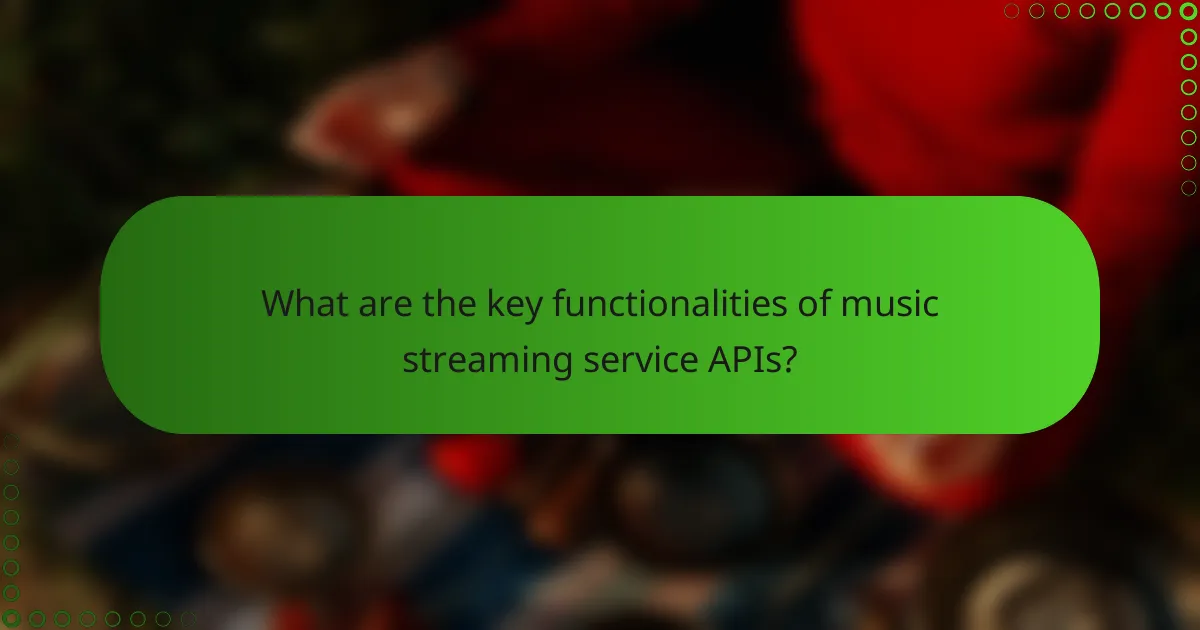
What are the key functionalities of music streaming service APIs?
Music streaming service APIs provide essential functionalities that enable developers to access, manage, and enhance music-related data and user experiences. Key features include data retrieval, user authentication, playlist management, playback controls, and integration with third-party services.
Data retrieval and management
Data retrieval and management functionalities allow developers to access vast libraries of music content, including song metadata, album details, and artist information. APIs typically support various query parameters to filter results, such as genre, release date, or popularity.
For effective data management, consider implementing caching strategies to minimize API calls and improve response times. This can help reduce latency and enhance the user experience, especially during peak usage times.
User authentication and authorization
User authentication and authorization are crucial for ensuring secure access to music streaming services. APIs often use OAuth protocols to allow users to log in with their existing accounts, granting permissions for data access while protecting sensitive information.
When implementing authentication, ensure a seamless user experience by minimizing the number of required steps. Additionally, regularly review and update permissions to maintain security and compliance with data protection regulations.
Playlist and library management
Playlist and library management functionalities enable users to create, modify, and share playlists easily. APIs typically provide endpoints for adding or removing songs, rearranging tracks, and managing user libraries.
To enhance user engagement, consider offering features like collaborative playlists or personalized recommendations based on listening history. This can encourage users to explore new music and share their favorite tracks with friends.
Streaming and playback controls
Streaming and playback controls are essential for providing users with a smooth listening experience. APIs allow developers to control playback functions such as play, pause, skip, and volume adjustments programmatically.
Implementing features like adaptive streaming can optimize audio quality based on the user’s internet connection. Additionally, consider including options for offline listening to cater to users with limited connectivity.
Integration with third-party services
Integration with third-party services enhances the functionality of music streaming APIs by allowing developers to connect with other platforms and applications. This can include social media sharing, music discovery apps, or even smart home devices.
When integrating with third-party services, prioritize user privacy and data security. Ensure that any shared data complies with relevant regulations and that users have control over their information and sharing preferences.
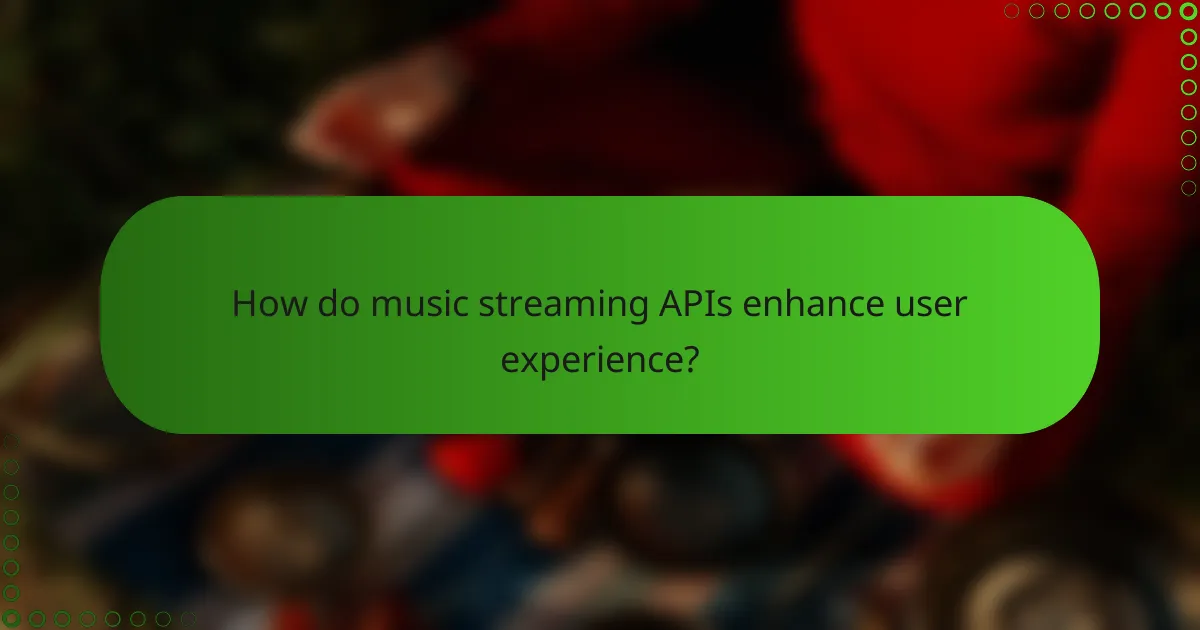
How do music streaming APIs enhance user experience?
Music streaming APIs significantly enhance user experience by providing personalized content, enabling social interactions, and ensuring accessibility across devices. These functionalities create a more engaging and tailored listening environment for users.
Personalized recommendations
Personalized recommendations are a key feature of music streaming APIs, utilizing algorithms to analyze user preferences and listening habits. By examining factors such as previously played songs, liked tracks, and user-generated playlists, these APIs suggest new music that aligns with individual tastes.
For instance, services like Spotify and Apple Music often present curated playlists based on user activity, which can introduce listeners to new artists and genres they might enjoy. This tailored approach can enhance user satisfaction and increase the time spent on the platform.
Social sharing features
Social sharing features allow users to connect with friends and share their musical discoveries easily. APIs enable integration with social media platforms, making it simple for users to post their favorite songs or playlists on sites like Facebook or Instagram.
This functionality not only fosters community engagement but also helps users discover music through their social circles. For example, a user might find a new favorite track simply by seeing a friend’s shared playlist, enhancing the overall music experience.
Cross-platform accessibility
Cross-platform accessibility ensures that users can enjoy their music seamlessly across various devices, including smartphones, tablets, and desktops. Music streaming APIs facilitate this by allowing users to log in and access their accounts from any device, maintaining their playlists and preferences.
This feature is particularly beneficial for users who switch between devices throughout the day. For example, a user can start listening to a podcast on their phone during a commute and continue on their laptop at home without losing their place, creating a fluid listening experience.

What are the best music streaming APIs available?
The best music streaming APIs include Spotify, Apple Music, Deezer, and SoundCloud. Each offers unique features and functionalities that cater to different developer needs and user experiences.
Spotify Web API
The Spotify Web API allows developers to access Spotify’s vast music catalog, user playlists, and personalized recommendations. It supports various functionalities such as searching for tracks, retrieving album details, and managing user libraries.
When using the Spotify API, consider the authentication process, which requires OAuth tokens. This ensures secure access to user data and allows for personalized experiences. Developers can also leverage the API’s rich metadata to enhance applications with detailed music information.
Apple Music API
The Apple Music API provides access to Apple Music’s extensive library, enabling developers to integrate music playback, playlists, and user recommendations into their applications. It also allows for the retrieval of album artwork and track previews.
To use the Apple Music API, developers must obtain an Apple Developer account and generate a MusicKit token for authentication. This API is particularly beneficial for apps targeting iOS users, as it seamlessly integrates with Apple’s ecosystem.
Deezer API
The Deezer API offers access to Deezer’s music catalog, including tracks, albums, and playlists. It provides features for searching music, retrieving user data, and managing playlists, making it a versatile option for developers.
When implementing the Deezer API, keep in mind the need for user authentication to access personalized data. The API also supports webhooks, allowing developers to receive real-time updates about user activities, enhancing interactivity within applications.
SoundCloud API
The SoundCloud API enables developers to access SoundCloud’s user-generated content, including tracks, playlists, and comments. It is particularly useful for apps focusing on independent artists and community-driven music sharing.
To utilize the SoundCloud API, developers need to register their application and obtain an access token. This API supports various endpoints for uploading tracks, managing user playlists, and integrating social features, making it ideal for music discovery platforms.
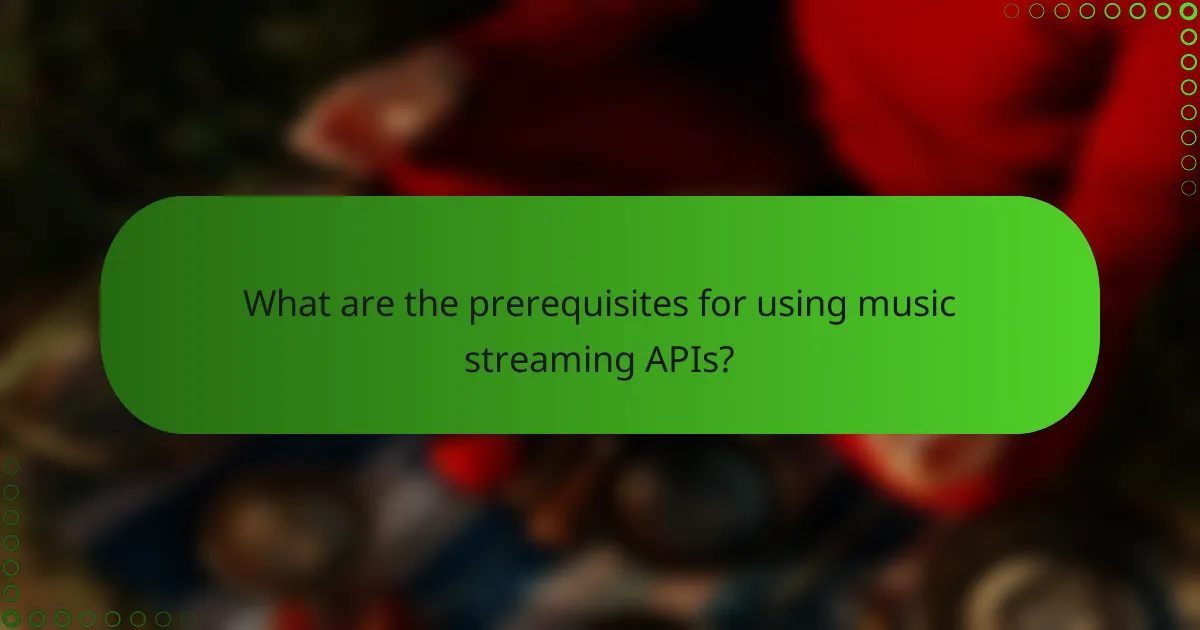
What are the prerequisites for using music streaming APIs?
To use music streaming APIs, you typically need to register for a developer account, generate an API key, and familiarize yourself with the API documentation. These steps ensure you have the necessary access and understanding to effectively integrate and utilize the API functionalities.
Developer account registration
Registering for a developer account is the first step to accessing music streaming APIs. Most platforms require you to provide basic information, such as your name, email address, and sometimes a company affiliation. This process often includes agreeing to terms of service and privacy policies.
After registration, you may need to verify your email address before gaining full access. Some services might also require additional verification steps, especially if you plan to use the API for commercial purposes.
API key generation
Once your developer account is set up, the next step is generating an API key. This key acts as a unique identifier for your application, allowing the music streaming service to authenticate your requests. The generation process is usually straightforward and can be completed through the developer dashboard.
Keep your API key secure, as it grants access to your account’s features. If compromised, you should regenerate the key immediately to prevent unauthorized use.
Understanding API documentation
Familiarizing yourself with the API documentation is crucial for effective integration. The documentation typically includes details on endpoints, request formats, response structures, and error handling. Understanding these elements will help you make successful API calls and troubleshoot issues.
Look for examples and code snippets in the documentation, as they can provide practical guidance on how to implement specific features. Additionally, pay attention to any rate limits or usage quotas to avoid service interruptions.
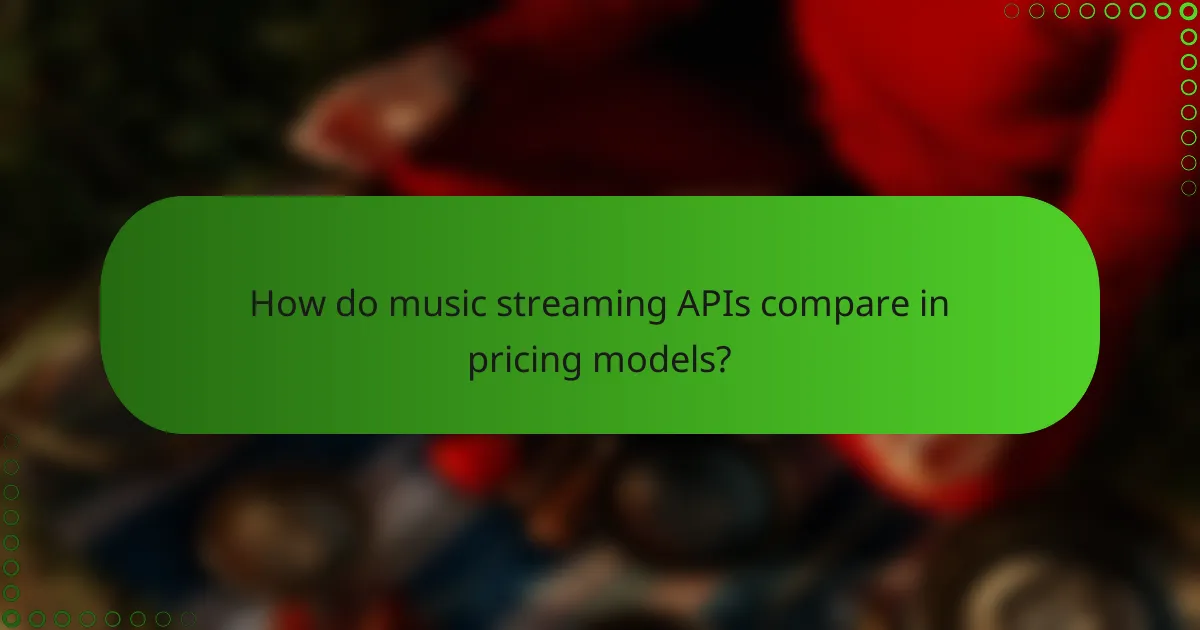
How do music streaming APIs compare in pricing models?
Music streaming APIs typically offer various pricing models, including pay-per-use, subscription-based, and tiered pricing. Understanding these models helps developers choose the best option based on their usage needs and budget constraints.
Pay-per-use pricing
Pay-per-use pricing allows developers to pay only for the API calls they make. This model is beneficial for applications with variable usage patterns, as costs can fluctuate based on demand. For instance, a small app may incur minimal costs during low traffic periods, while a popular app could see higher charges during peak times.
Subscription-based pricing
Subscription-based pricing involves a fixed monthly or annual fee for access to the API, often with a set number of calls included. This model provides predictable costs, making budgeting easier for developers. However, it may not be cost-effective for apps with sporadic usage, as unused calls do not roll over.
Tiered pricing
Tiered pricing combines elements of both pay-per-use and subscription models. Developers can choose from different tiers based on their expected usage, with higher tiers offering more features and lower per-call costs. This model can be advantageous for growing applications, as it allows for scalability without immediate high costs.

